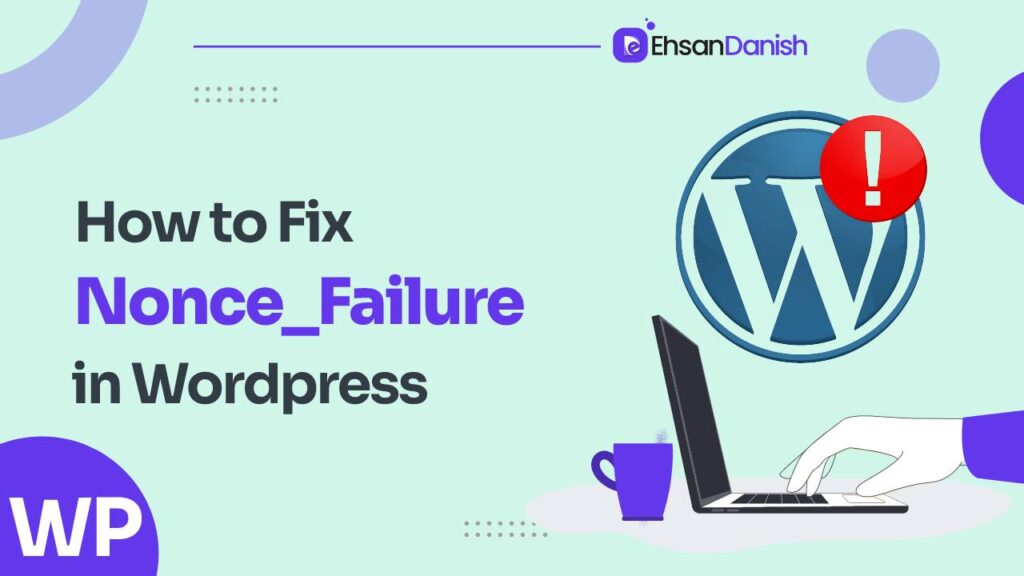WordPress is a versatile platform that empowers users to create and manage websites with ease. However, like any technology, it comes with its fair share of technical terms and challenges. One such term is “nonce failure,” which might seem confusing at first glance. In this article, we’ll demystify nonce failure in the context of everyday life, explore its implications in WordPress, and provide step-by-step guidance on How to fix WordPress nonce failure.
What Is Nonce Failure in WordPress?
Nonce, short for “number used once,” is a security feature in WordPress designed to protect against malicious actions, such as cross-site request forgery (CSRF) attacks. In simpler terms, it’s a unique token generated for specific actions to ensure that those actions are valid and initiated by authorized users, not by malicious scripts or attackers.
Everyday Life Analogy: Think of a concert ticket. The ticket has a unique QR code that allows you access to the event. This QR code is your “nonce.” It ensures that only those with valid tickets (nonces) can enter the event, preventing unauthorized individuals from gaining entry.
In WordPress, nonce failure occurs when the unique token, or nonce, generated for an action does not match the expected value. This can happen due to various reasons, such as expired sessions, cached pages, or server misconfigurations.
Implications of Nonce Failure in WordPress:
Nonce failures can have serious implications, especially in terms of security and user experience. If a nonce fails, it means that the action requested by the user cannot be verified as legitimate, potentially leading to unauthorized changes or actions on the website.
For example, imagine a scenario where a user attempts to submit a form to update their profile information on a WordPress site. If the nonce fails, it could prevent the user from successfully saving their changes, resulting in a frustrating user experience.
How to Fix WordPress Nonce Failure: Step-by-Step Guide
Nonces (number used once) in WordPress are essential for security, ensuring that actions are initiated by authorized users and not malicious scripts. If you encounter a nonce failure, where the generated token doesn’t match the expected value, it’s crucial to address it promptly. Here’s a detailed step-by-step guide to troubleshoot and fix nonce failures in WordPress:
Step 1: Clear Your Browser Cache
- Open Your Browser: Launch your preferred web browser (e.g., Google Chrome, Mozilla Firefox, Microsoft Edge, Safari).
- Access Browser Settings: Click on the three dots (Chrome/Edge), three horizontal lines (Firefox), or “Safari” in the top menu (Safari) to open the browser menu.
- Navigate to Clear Browsing Data: In Chrome or Edge, select “Settings” or “History” from the menu, then choose “Clear browsing data.” In Firefox, choose “Options” and then “Privacy & Security.” For Safari, select “Preferences” and go to the “Privacy” tab.
- Choose Time Range: In Chrome/Edge, select the time range for which you want to clear data (e.g., “Last hour,” “Last 24 hours,” “All time”). In Firefox, choose the time range from the “Cookies and Site Data” section. Safari does not have a time range option.
- Select Cached Images and Files: Ensure that “Cached images and files” is selected. You can also choose to clear other types of data if needed.
- Clear Data: Click the “Clear data” button in Chrome/Edge, or “Clear” in Firefox. In Safari, click “Remove All” in the “Manage Website Data” window.
Step 2: Disable Security Plugins
- Access WordPress Dashboard: Log in to your WordPress Dashboard.
- Go to Plugins: Navigate to the “Plugins” section on the left sidebar.
- Deactivate Security Plugins: Temporarily deactivate any security-related plugins you have installed. These plugins might interfere with nonce verification.
Step 3: Check Server Time
- Contact Hosting Support: If nonce failures persist, contact your hosting provider’s support to ensure your server time and WordPress timezone settings are accurate.
Step 4: Update WordPress and Plugins
- Update Core Files: Ensure your WordPress core files are up to date. You can check for updates under “Dashboard” -> “Updates.”
- Update Plugins: Similarly, update all your installed plugins from the “Plugins” section.
Step 5: Inspect Theme and Plugin Code
- Access Theme and Plugin Files: If you have custom code within your theme or plugins, review them for any potential conflicts related to nonce generation and verification.
Step 6: Verify Server Configuration:
- Contact Hosting Support: If the issue persists, contact your hosting provider’s support to verify that server configurations, such as security settings and caching mechanisms, are not causing nonce failures.
By following these steps meticulously, you can effectively troubleshoot and resolve nonce failure issues on your WordPress website. Remember that nonce failures are often caused by caching, server time discrepancies, or conflicting code, and addressing these factors will contribute to a secure and smoothly functioning WordPress site.
Conclusion:
Nonce failure might sound complex, but it’s a critical security measure that WordPress employs to protect your website from unauthorized actions. By understanding nonce failures through relatable everyday examples and following the troubleshooting steps outlined above, you can confidently navigate and address these issues, ensuring a secure and seamless experience for both you and your website visitors.


